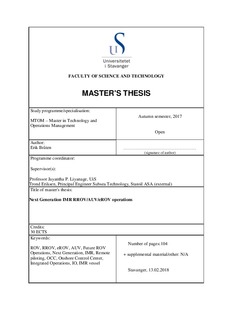| dc.description.abstract | The oil and gas industry is rapidly changing. The oil price is fluctuating and there has currently been an excess of personnel. Today's Remote Operated Vehicle (ROV) operations are demanding and costly, requiring a support vessel at all times. As subsea assets are aging, the need for inspection and new technology at a lower cost is increasing.
The specific problem for this thesis was to:
● Challenge today’s operations setup and mindset of ROV operation and look into future Resident ROV (RROV) / Autonomous Underwater Vehicle (AUV) and Empowered ROV (eROV) operations.
● Demonstrate possible economic benefit by adapting to new concepts and new technologies (business driven innovation).
New technologies such as Resident ROV (RROV) and Empowered ROV (eROV) are currently introduced and under development. The main feature of this technology is that it allows for remote piloting from an Onshore Control Center (OCC). There appears to be a paradigm change in which the ROV and the industry is becoming more and more electrified and autonomous. Comparison is made to other industries such as the aviation and automobile industry. In the latter, there is a powertrain shift moving to hybrids and electric vehicles. Key words in this new paradigm are “autonomous”, “resident” and “electric” (ref. FFU conference 2017).
This master thesis investigates ROV operations and the state of the art technology that is currently available. It outlines how the Company’s operations are planned and executed today and details new ROV technology under development. The thesis also reviews the Company’s resources available and estimates cost of establishing and running an Onshore Control Center (OCC).
As a theoretical basis, the master thesis uses Integrated (remote) Operations, Digitalization trends, Sharing Economy and Cost Effectiveness, Scenario Thinking and Dynamic resources and capabilities.
Today’s operations are planned manually. It requires a surface support vessel at all times due to the umbilical connected to the ROV. The ROV is controlled locally from the vessel. These operations are costly and gives limited flexibility.
An incentive for removing the umbilical - ROV working independently - has been going on for decades.
New developing technology allows signals to be transferred via fiber or using telecommunications, which opens up for controlling the ROV from an OCC. An OCC will give more flexibility because one ROV crew can control several ROVs at different locations subsea. This gives operational benefits.
Until ROVs in the future are fully autonomous (long term future scenario), a supporting vessel is required to move the eROV from one location to the other. The thesis uses towing as a concept to put the new eROV technology into an “operational context” in order to maximize use of the eROV concept.
Future operations also require a subsea infrastructure with hubs/docking stations to recharge the eROV and gain access to tooling etc. Until an infrastructure is fully established, relocation of the eROV from one location to another should be looked into in more detail - to optimize operations. Better planning and sharing of resources could lead to a more sustainable business model. This thesis shows that it is feasible to use towing as a method to relocate the ROV if the eROV concept is fully introduced and developed.
During the study the importance of people, processes and governance appeared - rather than just focusing on new technology. In order to succeed implementing new technology it is important that man, technology and organisation are connected and that collaboration is recognized.
If the cost assumptions in this thesis are correct, and if sharing of other support vessels/optimized operations is viable, the eROV concept could be a more sustainable business model. A certain number of ROV hours are needed to get the hourly ROV rate down as it is very costly to run an OCC around the clock (24 hours a day, 7 days a week). | nb_NO |
